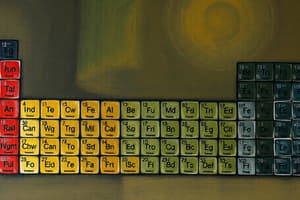Podcast
Questions and Answers
What is the hallmark of Mendeleev's periodic table?
What is the hallmark of Mendeleev's periodic table?
Its ability to anticipate the properties of previously unknown elements based on their position within the table.
How did Mendeleev demonstrate the predictive power of his periodic table?
How did Mendeleev demonstrate the predictive power of his periodic table?
By leaving gaps in the table for elements that were yet to be discovered.
What benefit did Mendeleev's periodic table provide in terms of simplification?
What benefit did Mendeleev's periodic table provide in terms of simplification?
It condensed a vast array of information into a single, organized grid.
How did Mendeleev's periodic table facilitate advancements in chemical research?
How did Mendeleev's periodic table facilitate advancements in chemical research?
What was Mendeleev's basis for classifying elements in his periodic table?
What was Mendeleev's basis for classifying elements in his periodic table?
Why has Mendeleev's periodic table endured for over a century and a half?
Why has Mendeleev's periodic table endured for over a century and a half?
What was the most notable change made to Mendeleev's periodic table by Henry Moseley in 1913?
What was the most notable change made to Mendeleev's periodic table by Henry Moseley in 1913?
How has the periodic table expanded over the years to accommodate more elements?
How has the periodic table expanded over the years to accommodate more elements?
What is the enduring value of Mendeleev's periodic table despite undergoing refinements?
What is the enduring value of Mendeleev's periodic table despite undergoing refinements?
Why is the replacement of atomic weight with atomic number significant in the periodic table's organization?
Why is the replacement of atomic weight with atomic number significant in the periodic table's organization?
What impact did Mendeleev's periodic table have on the fields of physics and materials science?
What impact did Mendeleev's periodic table have on the fields of physics and materials science?
Why have proposals for alternate periodic tables not been as powerful and enduring as Mendeleev's original concept?
Why have proposals for alternate periodic tables not been as powerful and enduring as Mendeleev's original concept?
Study Notes
The Enduring Value of Mendeleev's Periodic Table
In the realm of science, Dmitri Mendeleev's periodic table, first introduced in 1869, has stood as a powerful tool for organizing and understanding the properties of chemical elements for over a century and a half. This foundational concept in chemistry has benefited from consistent refinements, but its fundamental merits have not wavered.
Predictive Power
The hallmark of Mendeleev's periodic table is its ability to anticipate the properties of previously unknown elements based on their position within the table. For instance, Mendeleev famously left gaps in his first periodic table, confident that elements would be discovered to fill these spaces. His predictions proved correct with the subsequent discovery of germanium, gallium, scandium, and several other elements.
Simplification of Elemental Properties
Mendeleev's periodic table condensed a vast array of information into a single, organized grid. By grouping elements with similar chemical and physical properties, scientists gained a clearer understanding of the patterns that govern atomic behavior and chemical reactivity. Over the years, this clarity has facilitated significant advancements in chemical research.
Classification of Elements
Mendeleev's periodic table also introduced a systematic classification of elements based on atomic weight. This system made it possible to identify trends in atomic properties, such as atomic size, electron configuration, and chemical reactivity, which are essential to understanding the behavior of elements and predicting chemical reactions.
Periodic Table Refinements
Despite its enduring value, Mendeleev's periodic table underwent several refinements over the years. The most notable change was the replacement of atomic weight with atomic number as the basis for the table's organization. This revision, proposed by Henry Moseley in 1913, made the table more accurate by removing anomalies due to isotopes in some elements.
The Expanding Table
As more elements have been discovered, the periodic table has expanded to accommodate them. The periodic table now includes six groups (previously seven) and seven periods (previously eight), with each element assigned to a specific cell based on its atomic number.
The Future of Mendeleev's Periodic Table
The periodic table continues to serve as a foundational tool for scientists in their quest to understand and manipulate the elements. While there have been proposals for alternate period tables, none have proven to be as powerful and enduring as Mendeleev's original concept. In fact, the periodic table's ability to anticipate patterns in atomic behavior and chemical reactivity has inspired further research in the fields of physics and materials science.
Thus, it is clear that Mendeleev's periodic table remains a fundamental and enduring tool in the scientific community's quest to understand the elements, their properties, and their potential applications.
Studying That Suits You
Use AI to generate personalized quizzes and flashcards to suit your learning preferences.
Description
Explore the enduring significance of Mendeleev's periodic table in organizing chemical elements and predicting their properties. Learn about its predictive power, simplification of elemental properties, systematic classification of elements, and continuous refinements.




